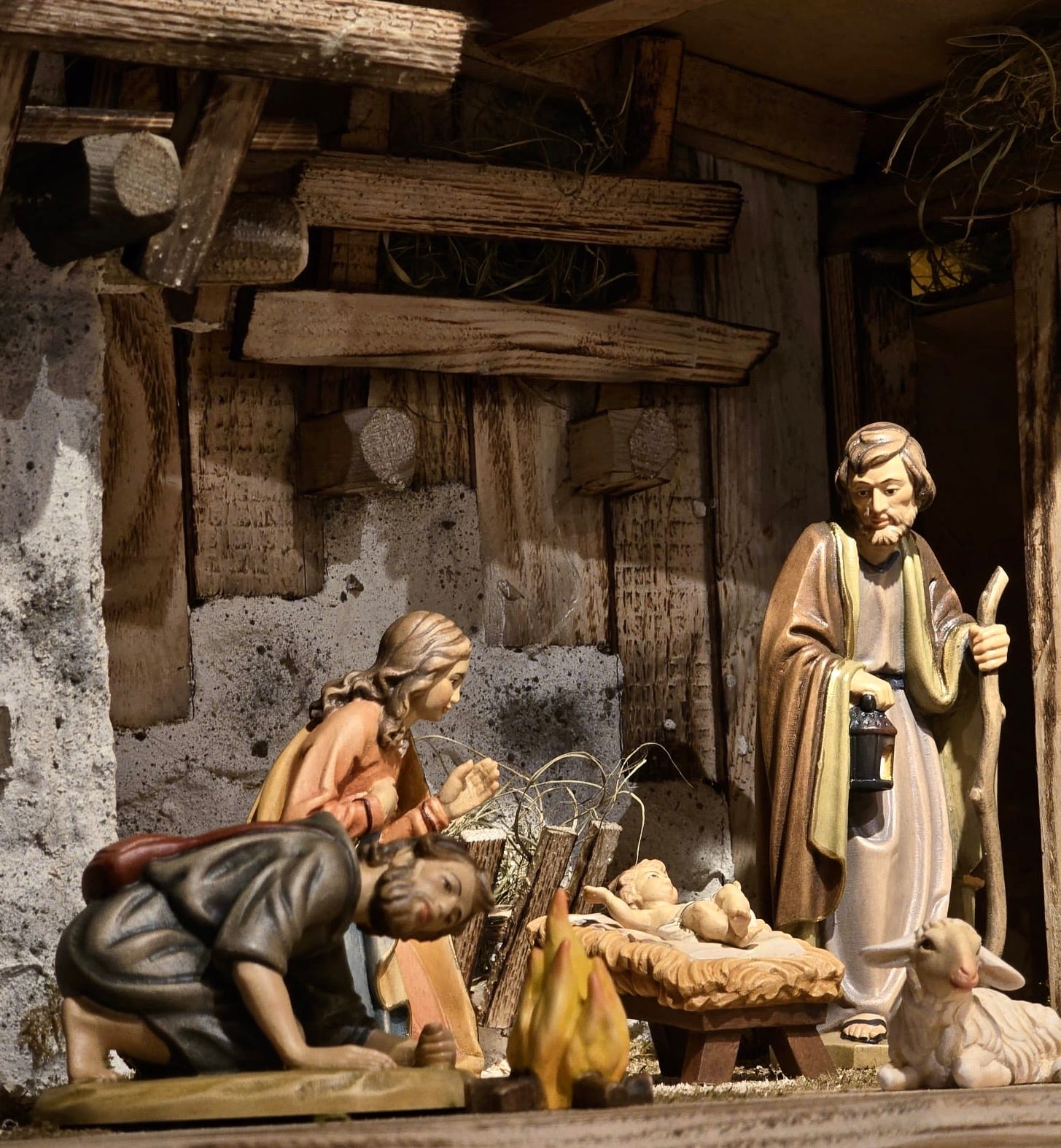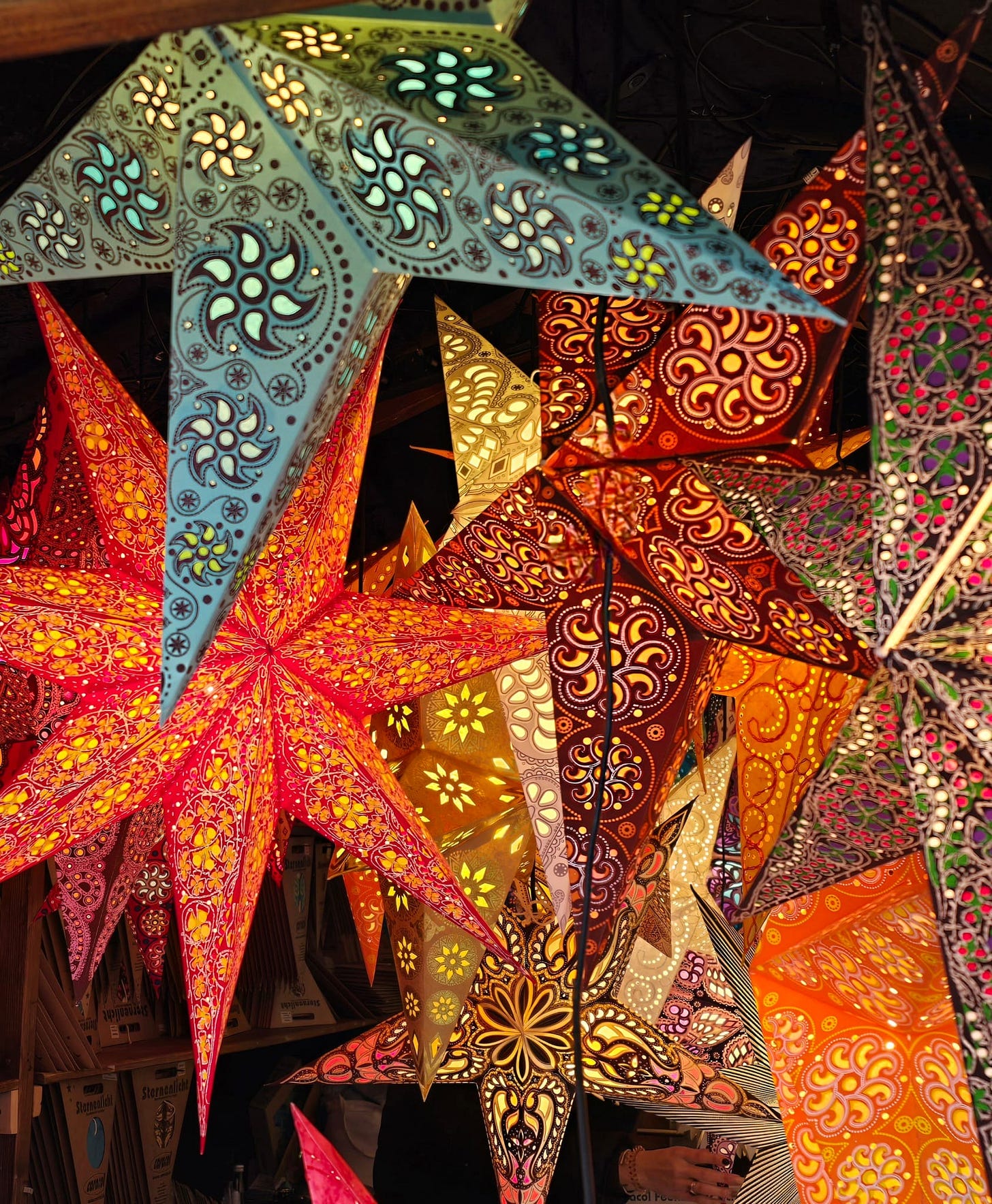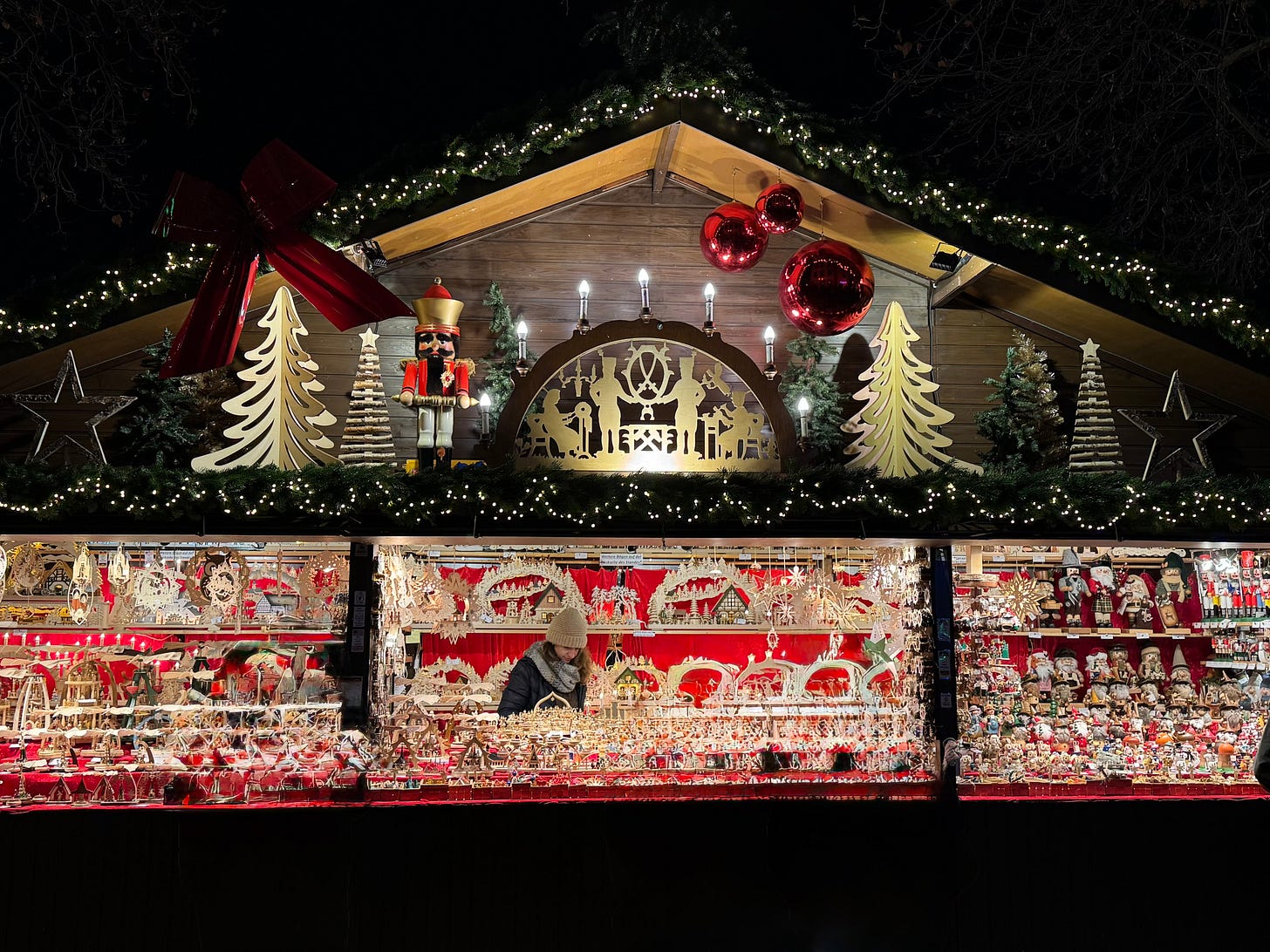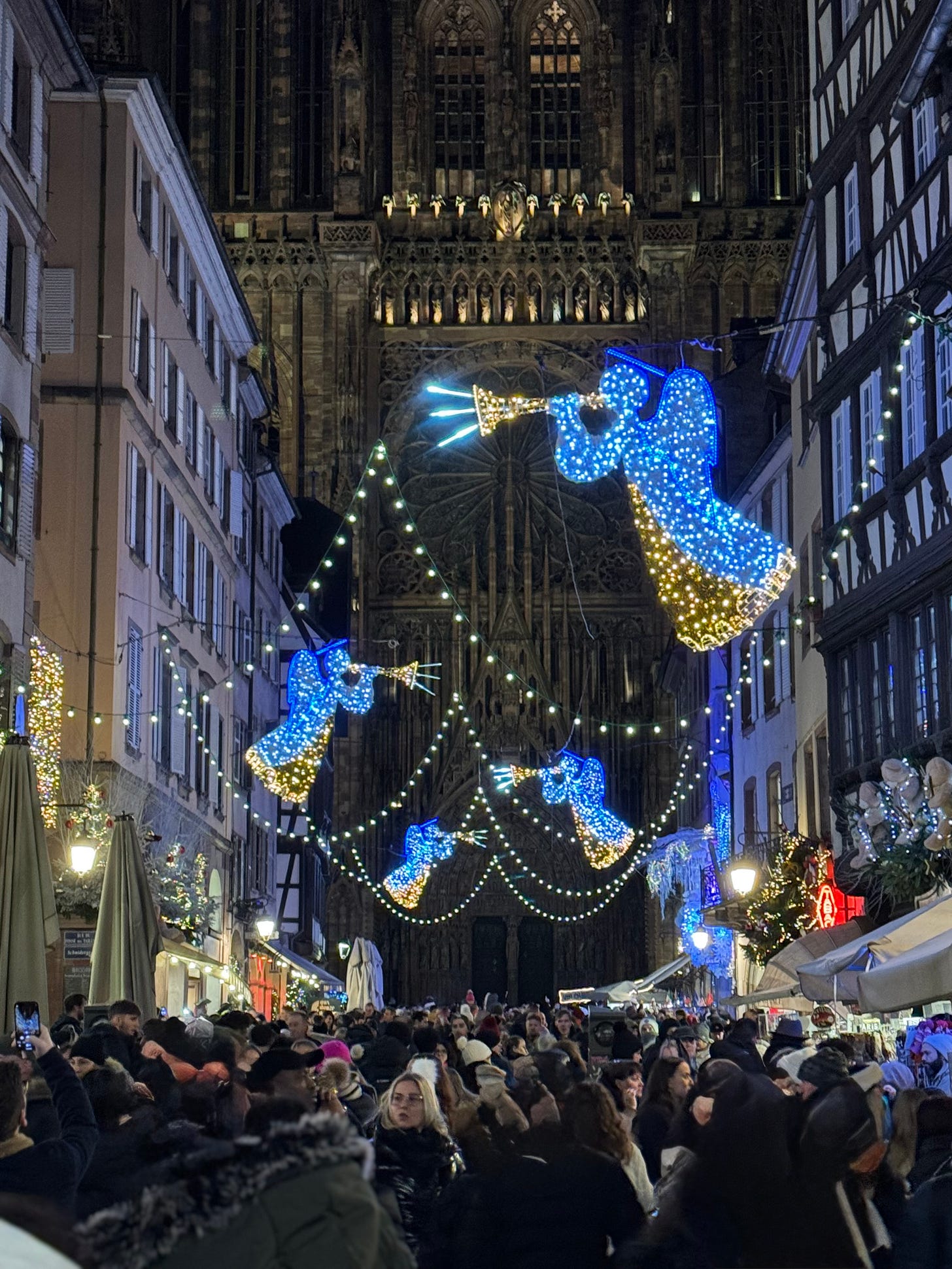As I sit down to write about the magic and joy of Christmas markets, my heart is heavy with the news of the recent tragic attack in Magdeburg, Germany. I am full of sorrow for the victims and their families during this devastating time.
I might as well have been six again.
On a recent crisp and frosty Stuttgart night, an enchanting vista of Christmas spread before me. Long inured to the innocuous and ubiquitous “happy holidays” and celebrating the “festive season”, this was a full on Christmas market, and not necessarily of the Santa variety.
There were nativity sets, and roasted chestnuts and glühwein and handmade finger puppets and the Three Kings and homemade jams and wooden handicrafts and angels with trumpets. It was crowds of festive market goers: families with starry-eyed children; friends celebrating the season; couples weighing the merits of festive paper stars or intricate ornaments to light up their holiday homes.
German Christmas market season was here, and it was magical.
Baby it’s cold outside
German Christmas markets, or Weihnachtsmärkte, can trace their origins back to the late Middle Ages in the German-speaking regions of Europe. Initially, they weren’t holiday events at all but rather winter markets, held to help townspeople stock up on essential goods before the coldest months of the year.
The earliest documented Christmas market is thought to be Vienna’s December Market, dating back to 1298, but it was Germany that truly embraced and developed the tradition. The Dresden Striezelmarkt, first held in 1434, is considered one of the oldest continuously running Christmas markets. Its name comes from "Striezel," a type of traditional German Christmas bread, now better known as stollen.
Still, those early markets were more about provisions and practicality, less about the festivities of the season and gift giving.
When we give cheerfully and accept gratefully, everyone is blessed.
—Maya Angelou, American poet, author, and civil rights activist
It wasn’t until the 16th century that Christmas traditions took a turn, thanks to the influence of the Protestant Reformation and Martin Luther. While gift-giving had traditionally been tied to St. Nicholas Day on December 6, Luther shifted the focus to Christmas Eve, emphasizing the celebration of Christ’s birth. This change also gave holiday markets a new role: they became the go-to destination for finding thoughtful, handmade gifts and festive treats.
By this time, these markets had evolved from simple winter fairs into lively holiday events. Craftsmen and artisans filled the stalls with beautifully crafted items such as hand-carved toys, wooden ornaments, candles, and seasonal delights like gingerbread. They became a cherished way for communities to gather, celebrate, and prepare for the holiday season.
Kindling hope and community
By the 19th century, the Romantic era brought renewed interest in Christmas traditions, including Christmas markets. This revival was further fueled after World War II, when Germany sought to rebuild its sense of community and cultural heritage.
Now German Christmas markets have gone global. Cities around the world, from Toronto to Tokyo, host their own versions of these markets, often modeled after the traditional German style. While some elements are adapted to local cultures, the core remains the same: community, craftsmanship, and celebration.
The enduring appeal of German Christmas markets lies in their ability to transport us to a simpler, more magical time. In a world dominated by online shopping and fast-paced living, Weihnachtsmärkte offer a chance to slow down and savour the holiday season. They remind us that the best gifts aren’t always the most expensive—they’re the ones made with care and given with love.
If you enjoy this weekly newsletter, please click on the ❤️ icon to like this post. This one gesture really helps to spread the word, and I appreciate it.
Potato latkes
Don’t Worry, Just Cook, Bonnie Stern and Anna Rupert
makes about a dozen latkes
Reibekuchen, or potato pancakes, are quite popular in Germany and are often a feature at Christmas markets. While they aren't uniquely tied to Jewish culture in Germany as they are in other parts of the world, their preparation and ingredients are very similar to latkes, making them a shared culinary tradition.
If there’s a definitive latke recipe better than Bonnie Stern’s, I don’t know it. We’ve been fortunate to eat these delicious treats many times at Bonnie’s and there’s nothing better than a hot-from-the-frying-pan latke. You can find Bonnie’s go-to recipe in the cookbook she co-wrote with her daughter, Anna Rupert.
Note: Bonnie often serves these as part of “latke bar”, with toppings to please everyone. Try sour cream and applesauce (traditional), smoked salmon, labneh or guacamole (my favourite 😊).
Ingredients
2 lb russet potatoes or Yukon Gold potatoes, scrubbed or peeled
1 large onion, cut into chunks
2 eggs
½ cup all-purpose flour, cornflake crumbs, or matzo meal
1 teaspoon kosher salt
⅛ teaspoon freshly ground black pepper
¼ cup unflavored vegetable oil, more as needed
Toppings of your choosing (see Note)
Grate the potatoes and onion using a box grater or food processor. Squeeze out as much liquid as possible using your hands or a clean towel.
Combine the eggs, flour, salt, and pepper in a large bowl. Add the grated potatoes and onion, mixing until evenly combined.
Heat oil in a skillet over medium-high heat. Scoop spoonfuls of the mixture into the pan and flatten slightly with the back of a spoon. Cook for 3–4 minutes per side until golden and crispy.
Place on paper towels to drain excess oil. Serve warm with your favourite toppings or keep warm in a 275°F oven.











What a great trip! Thank-you for sharing it with us.
(And great pictures, too!)